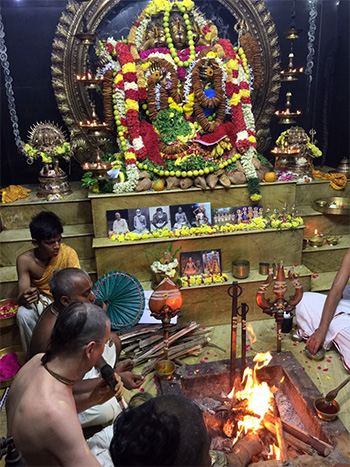Question: It has always been my understanding that the higher you go up in the 14 planetary systems, the subtler the inhabitant’s bodies are. I concluded that the lower you go, the opposite is also true. But, I’m not so sure any more. Would you be able to clear this issue for me?
Though it is true that the bodies become more subtle as we go up in the fourteen planetary systems, it is not true that the bodies become more gross as you go down below the earthly planetary system. In regards to the physical nature of objects, the earthly planet is the lowest or grossest. The seven lower planetary systems are actually heavenly planets. Srila Prabhupada uses the words “subterranean heavenly planets” (bila-svarga) to describe them. These lower heavenly planets are actually materially more opulent than the higher planets. This is because most of the inhabitants are demons, and their interest is only in sense enjoyment. These planets are mostly inhabited by yakshas, rakshasas, nagas and danavas, who are much subtler than us.
The Sutala-loka is ruled by Bali Maharaja, who is a rakshasa. The inhabitants of these planets are described as possessing similar qualities to those of the devas. For example, they do not grow old, they do not perspire, they do not get sick, and they do not get grey hair.
In the Vitala-loka, a form of Lord Shiva resides along with many bhutas (goblins). The bhuta is a lower human species than us, yet it is more subtle. The planetary system known as Talatala is ruled by the demon Maya Danava.
The Patalaloka is inhabited by the nagas, a type of heavenly snake. Nagas possess three forms, one as a human, one as a snake, and one as a half-human half-snake. They are able to change between these three forms at will. These nagas have special jewels on their hoods that emit tremendous light, and this light illuminates the entire subterranean heavenly planets. The light of the sun does not reach the lower planetary systems, so the inhabitants depend on the light from the nagas for illumination.
Among the fourteen planetary systems, only three systems are visible to the human eye. These are the bhur-loka, bhuvar-loka and svar-loka. Other planetary systems, even those situated below the earth, are not perceivable to us. Thus all the stars and planets we see in the night sky, even with the aid of a telescope, belong to these three planetary systems, with a few rare exceptions.
Below the fourteen planetary systems in the intermediate space between the Garbha ocean and the Patalaloka exists the abode of Yamaraja. There are two aspects to this abode, one is the Pitru-loka, where saintly and religious people dwell, and the other is the Naraka-loka, or the hellish planets where the sinful are punished.
It is interesting to note that even the lower species in the other planetary systems are more subtle than ourselves. For example, the animals in the gardens of heaven, nandan-kanana, are physically subtler than our own bodies, despite ourselves belonging to the higher human species. They may be generally within the mode of ignorance, as animals are, yet we are still elementally grosser than them. If for some reason one of these animals were to be standing before us, we would not even be able to see them unless they revealed themselves to us.
Within the human species, we find both higher and lower species who are more subtle than ourselves. Yakshas and rakshasas are higher, and naturally more subtle, but bhutas and pishacas are lower species than us, yet they are also more subtle.
The inhabitants of the lower planets are generally described as asuras (demons), but we must understand that asura is not a species but a mentallity. Yakshas, rakshasas, etc., are species, whereas asura is a level of consciousness. One may even be residing in svargaloka, but if he is averse to the service of the Lord then he is an asura. In this sense there are only two classes of men, sura and asura, or the devotee and the atheist.
The sura or deva is defined as follows:
vishnu-bhakto bhaved daivah
“Those who are devotees of Lord Vishnu are known as deva.”
The asura is defined by Lord Krishna at length in the sixteenth chapter of Bhagavad Gita, but in short it is like this:
pravrtitim ca nivrittim ca
jana na vidur asurah
na saucam napi cacaro
na satyam teshu vidyate
“Those who are demoniac do not know what is to be done and what is not to be done. Neither cleanliness nor proper behavior nor truth is found in them.”
Thus we find that there are many cases of people who are rakshasas, yet who aren’t asuras (demoniac). And on the other side we have people who are from higher births, yet are asuras by nature. One such example among the rakshasas is Bhakta Prahlada. Though being a rakshasa, he is the highest devotee of Vishnu.
Receive our daily email newsletter on Hinduism, Yoga, Meditation, Ayurveda and Natural Healing.






